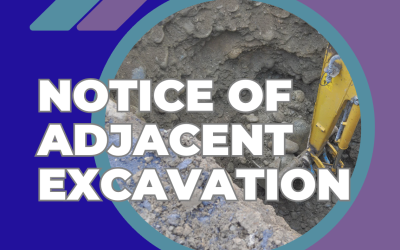What are Party Wall Works?
Party Wall Surveying procedures are applicable for specific types of construction works.
We thought we would look at these works in a little more detail, to help best inform you of the mechanisms that make up the Party Wall procedures and the type of information the Party Wall Surveyor will be reviewing in the process of agreeing the Party Wall Award.

Internal Works
Internal works that fall within the remit of the Party Wall etc Act 1996 and require Party Wall procedures to be followed include the following:
Removal of Chimney Breasts
Both the cutting away of the Chimney Breast attached to the Party Wall and then associated support, often to support the remaining stack or breast, are covered by the Party Wall etc Act 1996.
Removals of Walls tied into the Party Wall
Both the cutting away of the Wall attached to the Party Wall and then associated support, often to support the open plan room arrangement are covered by the Party Wall etc Act 1996.
Internal Excavations, often required to facilitate open plan rooms
In order to facilitate open plan room arrangements, ground beams or pad foundations will often be required. The excavations associated with these are covered by the Party Wall etc Act 1996.

Loft Conversions
Loft Conversions are one of the most common types of construction work that fall within the remit of the Party Wall etc Act 1996 and require Party Wall procedures to be followed.
With a loft conversion, the Act’s requirement is twofold, first for the removal of the existing roof covering thereby exposing the Party Wall. Secondly, for cutting into the Party Wall for the insertion of the steel support beams that facilitate the loft conversion.

Extensions
Rear, Side and Front Extensions are one of the most common types of construction work that fall within the remit of the Party Wall etc Act 1996 and require Party Wall procedures to be followed.
First and foremost, extensions require excavations for the new foundations, which will often be at a greater depth than the existing property foundations, thereby requiring the service of Party Wall Notices.
Secondly, if the new flank wall of the extension is built up to or astride the boundary line, this will also require the service of Party Wall Notices.

Basement Conversions
With living space at a premium, and complex construction works becoming more cost effective to implement, more and more homeowners are embarking on Basement Extensions.
Basement Conversions fall within the remit of the Party Wall etc Act 1996 and require Party Wall procedures to be followed.
In undertaking a basement extension, both the deep excavations will fall within the remit of the Act. As will the underpinning to the existing Party Wall or adjoining owner’s wall that will be required as part of the proposed works.

New Walls
The construction of new walls is dealt with twofold under the Party Wall etc Act 1996. Firstly, new walls, often forming the flank walls of proposed extensions. Secondly, if a new wall is being up to, or on the boundary line. Both of these require the service of Party Wall Notices under the Party Wall etc Act 1996.

Other Works
The Party Wall etc Act 1996 also covers various other types of works that are less commonly understood to fall within its remit. These include however are not restricted to the following:
Changing Roof Coverings
Updating and Changing Roof Coverings, for example when the existing tiles have reached the end of their useful life. The removal of the old tiles, will expose the Party Wall and is therefore considered to be notifiable work under the Party Wall etc Act 1996.
Demolishing a Structure attached to the Party Wall
Removing or demolishing a structure attached to the Party Wall will be notifiable work under the Party Wall etc Act 1996. Commonly this could be removing an outhouse, an extension, or a storage building. These works are covered by the Act twofold, firstly the cutting away of the structure itself. Secondly exposing the Party Wall, once removed.
Removing a Chimney Stack
Removing a chimney stack in whole, or just half, is notifiable under the Party Wall etc Act 1996. These works are covered twofold, firstly the cutting away of the structure itself. Secondly exposing the remaining stack, or adjoining owner’s roof, once the stack is removed.
It is worth noting that the removal of the entire stack can only take place with the adjoining owner’s consent.
Do I need a Party Wall Notice?
We’re going to take a look at the definitions and construction scenarios that give rise to the need for a Party Wall Notice.

Works directly to a Party Wall
Construction works directly to the Party Wall will require the building owner to serve a Party Wall Notice upon the adjoining owner a minimum of 2 months prior to the planned works commencing. It is important to note that the works don’t need to be structural for the Party Wall etc Act 1996 to apply.

Works directly to a Party Fence Wall
Construction works directly to a Party Fence Wall will require the building owner to serve a Party Wall Notice upon the adjoining owner a minimum of 2 months prior to the planned works commencing. A Party Fence wall is a shared garden wall that is in equal ownership of the building owner and adjoining owner. It is important to note that timber & concrete fences fall outside the scope of the Party Wall etc Act 1996.

Works directly to a Party Structure
Construction works directly to a Party Structure will require the building owner to serve a Party Wall Notice upon the adjoining owner a minimum of 2 months prior to the planned works commencing. A Party Structure is the horizontal divide between Flats, Maisonettes and Flying Freeholders. Commonly floors or ceilings.

Excavations within 3 metres
Excavation or digging within 3 metres of any neighbouring structure will require the building owner to serve a Party Wall Notice upon the adjoining owner a minimum of 1 month prior to the planned works commencing. It is important to note that the excavations also need to be deeper than the foundations of the neighbouring structure for the Party Wall etc Act 1996 to be applicable.

Excavations within 6 metres
Deep excavation or digging within 6 metres of any neighbouring structure will require the building owner to serve a Party Wall Notice upon the adjoining owner a minimum of 1 month prior to the planned works commencing. It is important to note that the excavations also need to be deeper than the foundations of the neighbouring structure at a 45 degree intersect for the Party Wall etc Act 1996 to be applicable. This is likely to only apply to piled foundations or deep basement works.
Typical Party Wall Surveying Questions & Video FAQ

Closed
What happens if Party Wall Damage occurs?
 In the event that damage occurs to the adjoining owner’s property, the first point of call is to establish if indeed that damage is new, and as a result of the building owner’s construction works.
In the event that damage occurs to the adjoining owner’s property, the first point of call is to establish if indeed that damage is new, and as a result of the building owner’s construction works.
If indeed it is determined to be resultant from the building owner’s construction works, at that stage the Party Wall Surveyor will then quantify the damage and ultimately ensure that this is rectified in accordance with the adjoining owner’s requirements.
The adjoining owner has the right to have the building owner’s contractor repair the damage, or they can request a cash payment so that they can instruct their own contractor.
Do the Party Wall Surveying Procedures allow access?
 Yes, the Party Wall etc. Act 1996 does allow a building owner legal access onto an adjoining owner’s land.
Yes, the Party Wall etc. Act 1996 does allow a building owner legal access onto an adjoining owner’s land.
In order for this access to be applicable, certain types of Party Wall works need to be undertaken.
If you would like to discuss these types of works in greater detail, we would recommend getting in touch with our experienced team of qualified chartered surveyors.
Are Party Wall Surveyors qualified?
 The Party Wall etc. Act 1996 doesn’t require a Party Wall Surveyor to posses any formal qualifications.
The Party Wall etc. Act 1996 doesn’t require a Party Wall Surveyor to posses any formal qualifications.
In effect anyone, aside from the building owner or adjoining owner, can refer to themselves as a Party Wall Surveyor.
For this reason it is imperative that the Party Wall Surveyor is selected based off their experience and qualification.
All of our Party Wall Surveyors are not only qualified with leading governing bodies, but are also very experienced Building Surveyors and Party Wall Surveyors.
Here are some Party Wall Surveying projects we've done in the past:

Rutland Mews South, Knightsbridge, SW7
The Stokemont team were very pleased to be able assist with the completion of a Party Wall Surveying Schedule of Condition Report for a stunning mews house located on Rutland Mews South, Knightsbridge, SW7. The neighbouring works included a single storey basement conversion and extension on Rutland Street.
Timeline: 27 days

High Street Kensington, London, W8
The Stokemont team were very pleased to be able assist with the completion of a Party Wall Award for this mid level flat located on High Street Kensington, London. The construction works included the removal of internal structural walls, the introduction of new steel support and the replacement of floors and ceilings.
Timeline: 12 days

St Stephen's Terrace, Stockwell, SW8
The Stokemont team were very pleased to be able assist with the service of Party Wall Notices, a Schedule of Condition Report and Agreement of a Party Wall Award on this mid terraced turn of the century home on St Stephen's Terrace, Stockwell. The Party Wall works included the installation of steel work into the Party Wall and relocation of internal walls.
Timeline: 22 days
Team Qualifications
Our team of surveyors are not only highly experienced but importantly they are also qualified.
We’re proud to confirm our surveyors hold membership status and accreditation to some of the world’s leading professional governing bodies including; the Royal Institute of Chartered Surveyors (RICS), the Chartered Institute of Arbitrators (CIArb), The Chartered Association of Building Engineers (CABE) and the Pyramus and Thisbe Club (P&T).
Advice Centre
Support Your Local Pub
The UK pub sector is facing a serious and on-going crisis with an average of six pubs closing each week over 2024. This hasn’t improved in 2025, so far close to 300 establishments in England and Wales have shut their doors permanently. While this hits the already...
Notice of Adjacent Excavation
Under the Party Wall etc. Act 1996, excavation (digging) work within six metres of any neighbouring buildings or structures gives rise to the need for a Party Wall Notice. You will often hear party wall surveyors refer to the works that fall within the scope of the...
What Makes a Great Party Wall Surveyor?
Having undertaken party wall surveying work for well over 15 years, we thought we would share our thoughts on what makes a great party wall surveyor. A great party wall surveyor brings much more to the table than just an understanding of the Party Wall etc. Act 1996....










